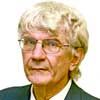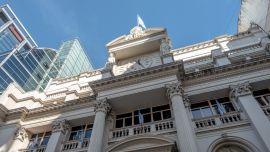That half-century of 1880-1930 providing the backdrop for this book is something of an orphan of Argentine history, lost in a nostalgic haze of the “golden years” while lacking any real substance. On either side of that period there are chronicles of events – the independence and civil wars of the first half of the 19th century with that unique figure of the “tyrant anointed by God” Juan Manuel de Rosas beforehand and the military-civil alternation of the subsequent coup-ridden half-century with living memory taking over from there – but no real milestones between the creation of the Federal Capital in 1880 and the first democratic elections in 1916 with neither the 1890 Revolution nor the 1910 centenary breaking the continuity. With the exceptions of Julio Argentino Roca and Hipólito Yrigoyen, the names from that period have faded into oblivion – how many people in the street could tell you who Manuel Quintana was, for example?
The Teatro Colón dates from that period (1908) but is not even mentioned in this book – instead the focus is the lowbrow entertainment of the sainete, usually one-act plays often musical and grotesquely satirical in intention. Victoria Cox’s book is nominally cultural history but since the sainetes are almost devoid of literary merit (as may be seen from the direct quotations), the real value of these pages is social comment, which also comes as a counterbalance to the glorification of those years by the current Javier Milei administration. That social comment which can be gleaned from the undertones of the sainetes is expressed rather more directly by the Spanish republican Eduardo Sojo (1849-1908), who found himself on these shores between 1883 and 1892, editing the weekly Don Quijote en Buenos Aires.
Since those years included the Miguel Juárez Celman presidency when a speculative bubble burst with the 1890 financial crisis, Sojo centres on corruption while ignoring the development also underway but his critique serves as a corrective to the idealisation of that period – thus while the railways opened up the country, the motives for building these symbols of national progress are shown as the juicy speculation from the land sales rather than high-minded patriotism. Sojo also takes issue with the glorification of then-City mayor Marcelo Torcuato de Alvear as the architect of “the Paris of South America,” rubbishing him as “Palmerín” for lining streets with useless palm trees while the grim conventillo tenements proliferated – one of the clowns in the circus alongside Juárez Celman, his minister Eduardo Wilde and even General Roca. His writings show how the primitive level of the sainetes reflect a more general misery while the third chapter of this book is dedicated to demonstrating that the 1871 yellow fever was not the only pandemic of that period with chronic cholera. Other writings of this period show that the immigrants were subject to a much more widespread xenophobia (including from the élite) than generally believed with their upward social mobility a precarious process.
While Sojo’s outlook dominates the first five chapters of this book, Victoria Cox returns to the sainete as a mirror of society in the next two before concluding with an analysis of Julio Cortázar’s books on the tangos of the first half of the 20th century. The sixth chapter picks up the sainete “El inglés de Santa Cruz” (1923) to look at the fascinating topic of anarchism and its confrontation with often British latifundia in Patagonia while the seventh has a feminist theme, running through various one-act plays and tangos to show how a woman’s life outside the family was constricted into an either/or proposition of being a respectable seamstress or a “perdida” (“lost soul”) in a cabaret.
In summary, this book contributes less to cultural history than to balancing that golden haze made to surround Argentina’s pre-democratic years, bringing the ordinary people of that period to life via myriad details revealed by their popular entertainment.


















Comments